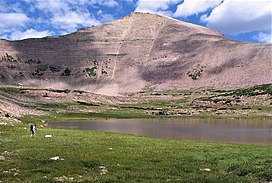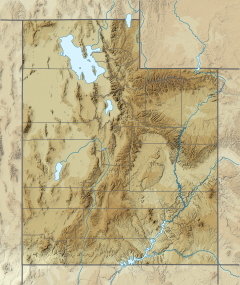| Explorer Peak | |
|---|---|
 Southeast aspect, from Ottoson Basin | |
| Highest point | |
| Elevation | 12,708 ft (3,873 m) [1] |
| Prominence | 668 ft (204 m) [2] |
| Parent peak | Kweeyahgut Peak (12,855 ft) [3] |
| Isolation | 1.25 mi (2.01 km) [3] |
| Coordinates | 40°43′05″N 110°38′39″W / 40.7181748°N 110.6440433°W [4] |
| Geography | |
| Location | High Uintas Wilderness |
| Country | United States of America |
| State | Utah |
| County | Duchesne |
| Parent range |
Uinta Mountains Rocky Mountains |
| Topo map | USGS Explorer Peak |
| Geology | |
| Age of rock | Neoproterozoic |
| Type of rock | Metasedimentary rock |
| Climbing | |
| Easiest route | class 2 scrambling [3] |
Explorer Peak is a 12,708-foot elevation (3,873 m) mountain summit located in Duchesne County, Utah, United States.
Description
Explorer Peak is set within the High Uintas Wilderness on land managed by Ashley National Forest. It is situated in the Uinta Mountains which are a subset of the Rocky Mountains, and it ranks as the 38th-highest summit in Utah. [5] Topographic relief is significant as the west aspect rises 1,700 feet (520 meters) in less than one-half mile and the north aspect rises 1,440 feet (440 meters) above Crater Lake in one-third mile. Neighbors include Dead Horse Peak three miles to the northwest and Mount Lovenia three miles northeast. Precipitation runoff from this mountain drains west to Fall Creek and east into tributaries of the Lake Fork River. The landform's toponym was officially adopted in 1957 by the U.S. Board on Geographic Names to honor the Explorer Scouts. [6]

Climate
Based on the Köppen climate classification, Explorer Peak is located in a subarctic climate zone with cold snowy winters and mild summers. [7] Tundra climate characterizes the summit and highest slopes.
See also
References
- ^ United States Geological Survey topographical map - Explorer Peak
- ^ "Explorer Peak, Utah". Peakbagger.com. Retrieved 2022-08-06.
- ^ a b c "Explorer Peak - 12,708' UT". listsofjohn.com. Retrieved 2022-08-06.
- ^ "Explorer Peak". Geographic Names Information System. United States Geological Survey, United States Department of the Interior. Retrieved 2022-08-06.
- ^ Utah 12,000-foot Peaks, peakbagger.com
- ^ United States Board on Geographic Names (1957), Decisions on Names in the United States, Decision List 5701, Department of the Interior, p. 10
- ^ Peel, M. C.; Finlayson, B. L. & McMahon, T. A. (2007). "Updated world map of the Köppen−Geiger climate classification". Hydrol. Earth Syst. Sci. 11 (5): 1633–1644. Bibcode: 2007HESS...11.1633P. doi: 10.5194/hess-11-1633-2007. ISSN 1027-5606. S2CID 9654551.
External links
- Explorer Peak: weather forecast

